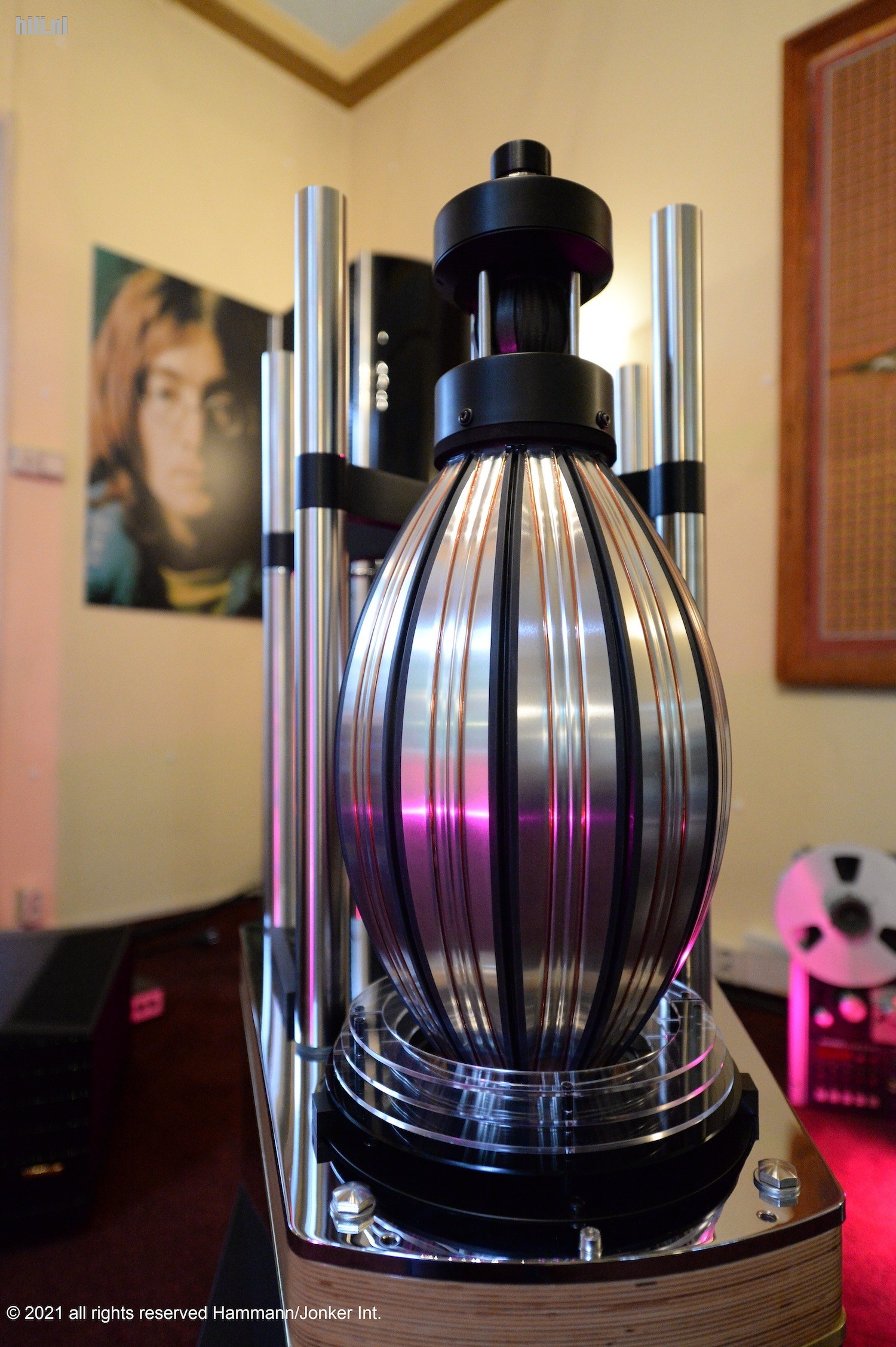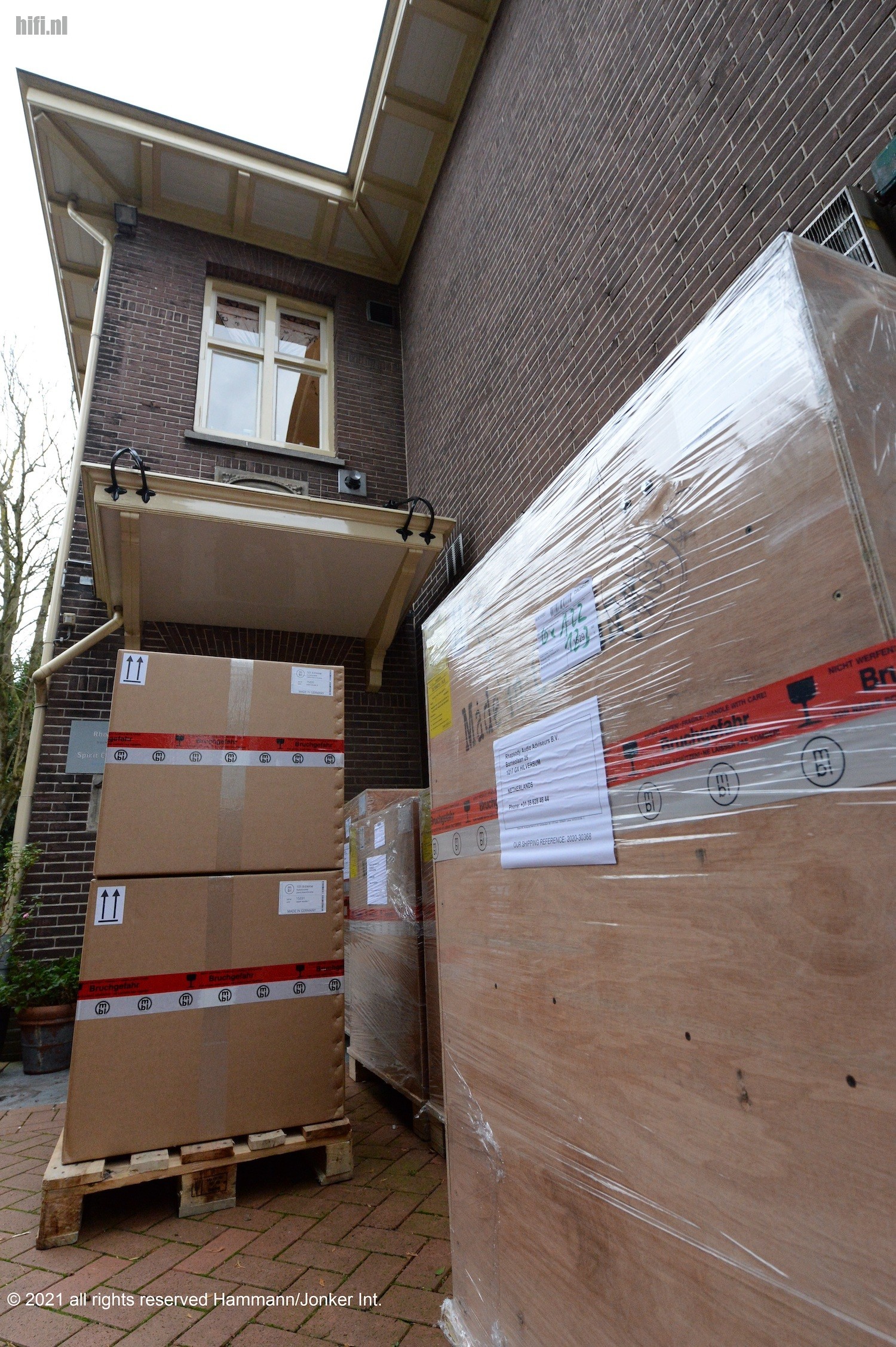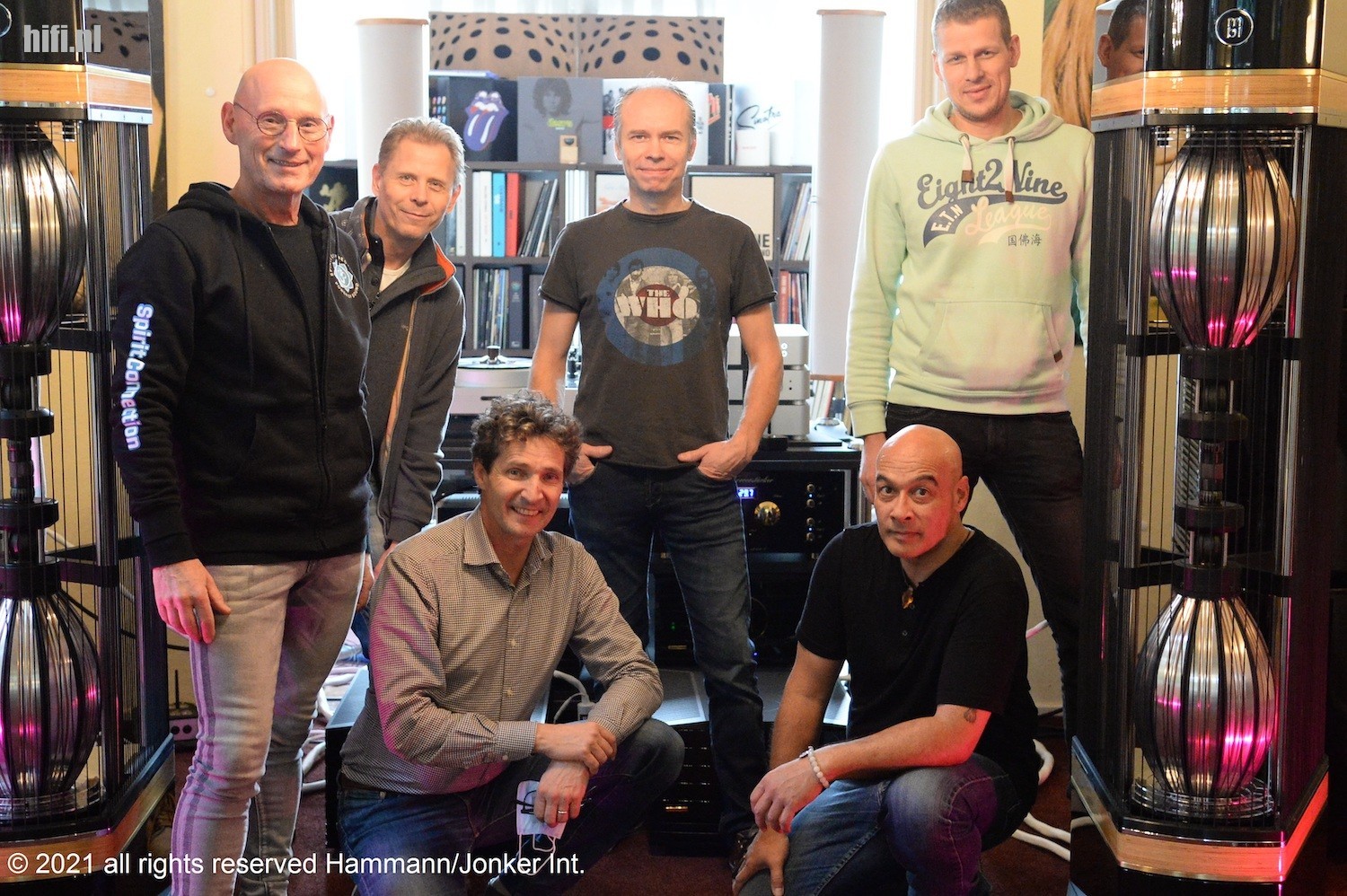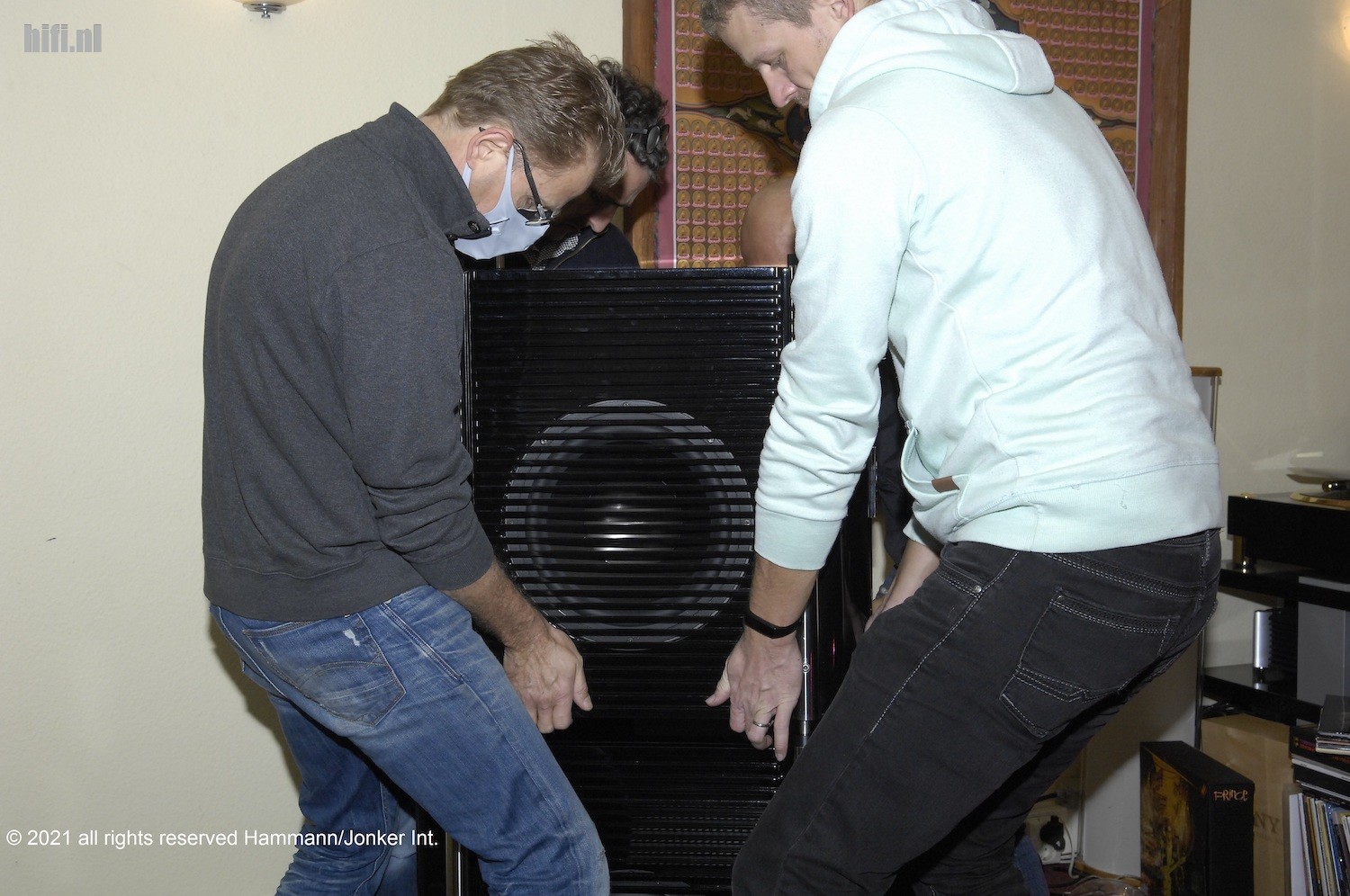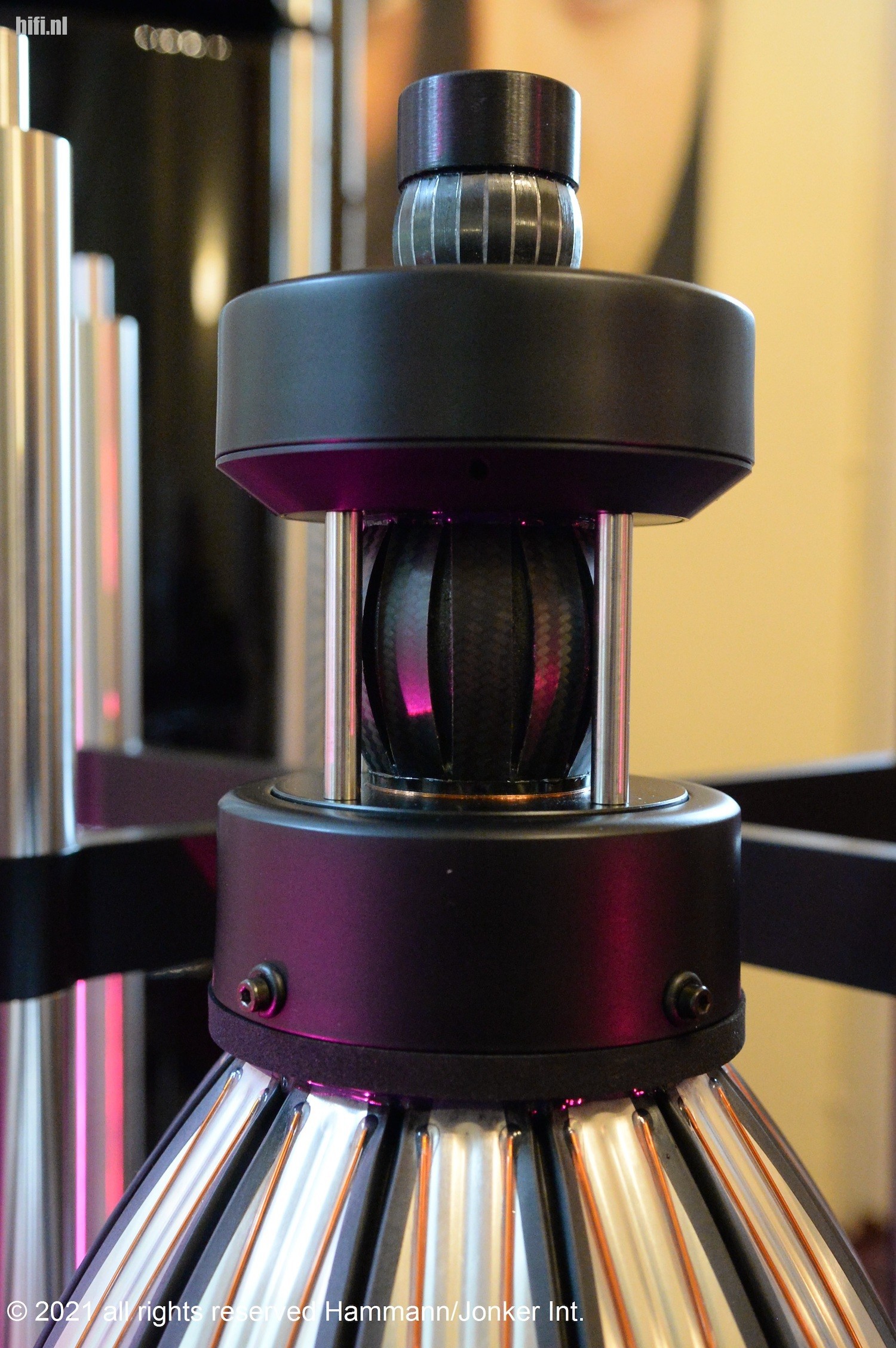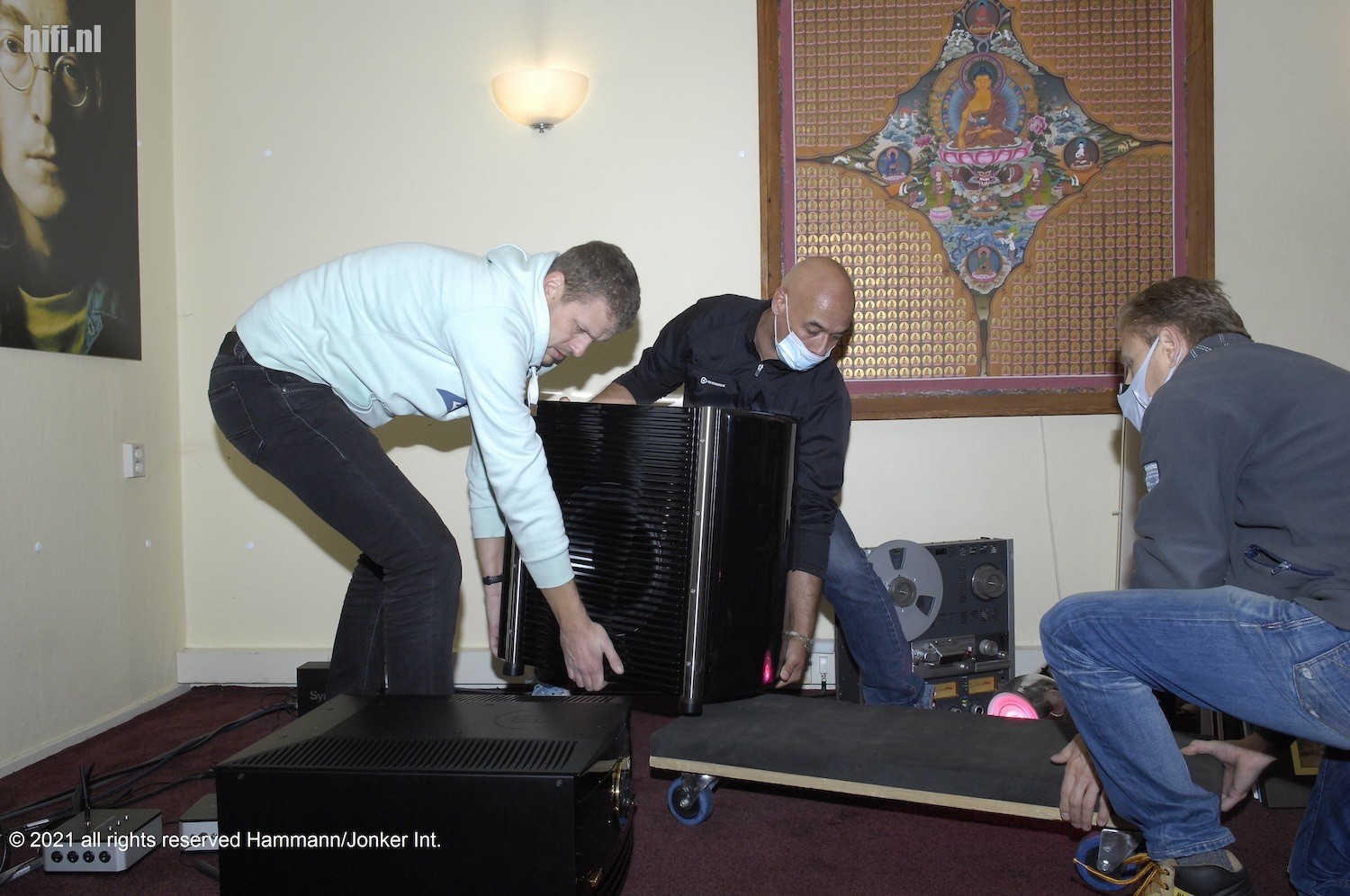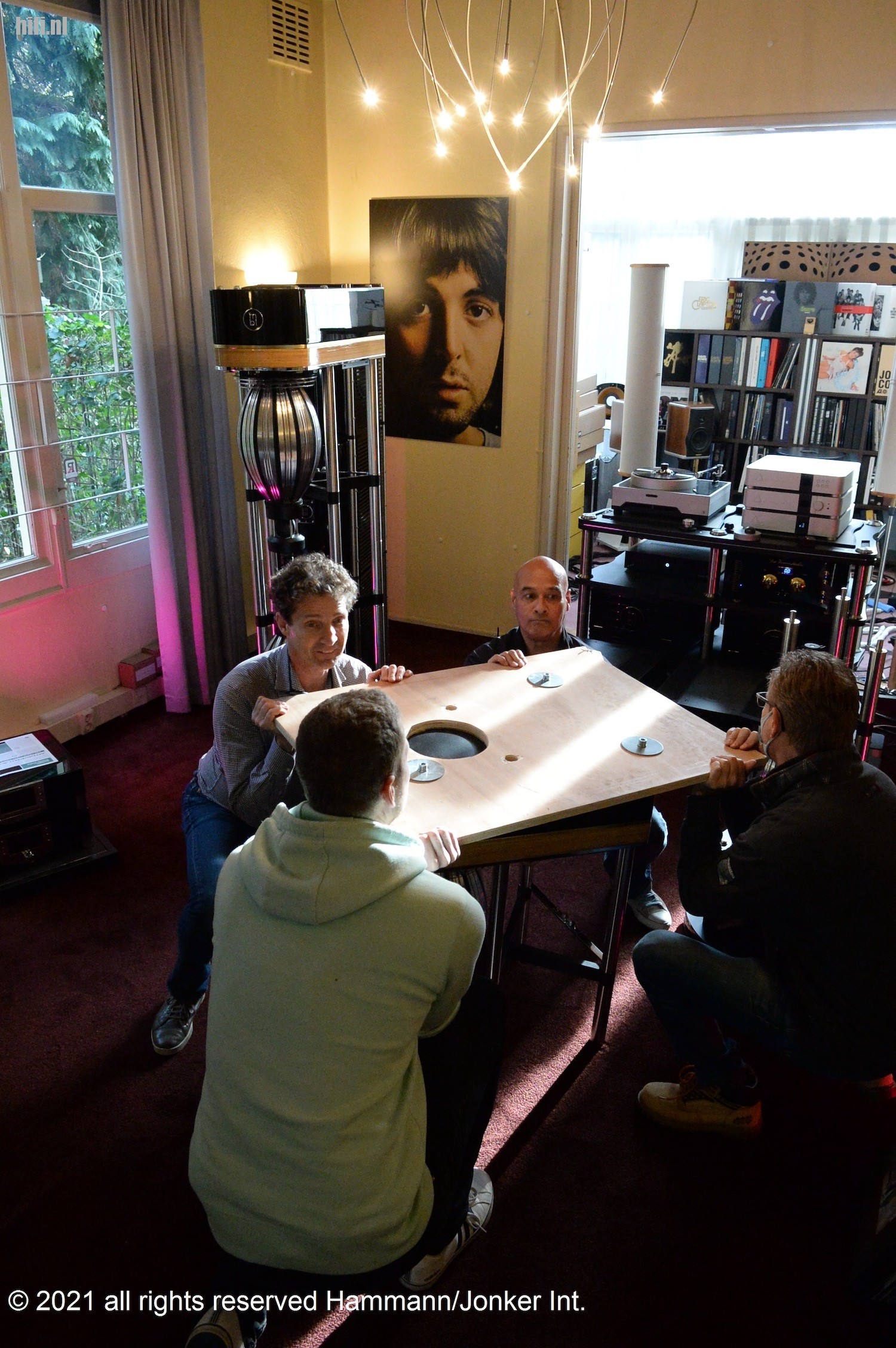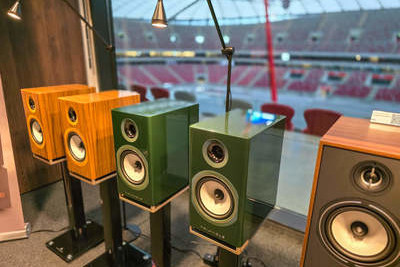While society remains in the grip of the pandemic, HIFI.NL offers distributors and dealers some help in the form of our Hi-Visits. A formula that ensures that audio companies do not disappear out of sight and out of mind for music lovers, given the fact that a physical visit to shops is a bit more difficult nowadays. For our latest edition, we're heading towards Hilversum, where the Netherlands most favorite high end outlet once again challenges the imagination of music lovers. The nefarious scheme this time was to demonstrate MBL's 101 X-treme Omni-directional loudspeaker and to write a report on the build-up of this system.
In addition, there was a conversation with Jürgen Reis, the designer of the system. During the second visit we listened and a short impression followed. Some weeks later there was a third listening session, after some additional system tuning. Following the text and photographs you can see the set-up of the system. | Voor Nederlands, klik hier.
Radialstrahler
Omni-directional loudspeakers have been buzzing for decades. Many different types were and are available. Even electrostatic omnis, such as the Muraudio PX-1, which works omni directionally above 450Hz and also below this frequency, but with dynamic bass drivers. But also models from German Physiks, Duevel, the Dutch Temporal Coherence and many others.
The discussion has to do with the so-called directivity of loudspeakers, or the radiation behavior. In a nutshell, the fundamental issue is very simple. How does the directivity of a speaker system affect the subjective quality experience of the reproduced music? You can formulate that even more simply. Namely, which radiation pattern is most representative for the natural reproduction of music (the reality)?
Lots of research
Unsurprisingly, there is a huge amount of research literature on this topic and opinions among scientists and loudspeaker designers vary widely. Floyd Toole has written articles and books about this, but many theoretical pieces are available on the AES website. Omni directional ideas gave rise to very different solutions in the market. From JBL (for example the M2 Master Reference Monitor), the Kii Audio Three, the BeoLab 90 (adjustable directivity) and in the past, for example, the Bose models with Direct Reflecting technology. Those who want to experience spatial reproduction can probably be quite satisfied with the phenomenal Bose 901, but it's mandatory to match it with the best electronics available. But, although many claim the ideal solution, unfortunately the holy grail does not yet exist. Some time ago, a study was presented at the 126th AES Convention. Titled Effects of loudspeaker directivity on perceived sound quality. This article provides a summary of the knowledge at that time and concludes that there are still far too few test results, based on listening experiences, with all kinds of systems of different directive nature.
Multiple factors
This author believes that realistic and natural rendering of sound depends on several factors, including directivity. This Hi-Visit is about an omni-directional loudspeaker system. However, the question is whether that further enables the ultimate natural and realistic reproduction. Are current omni directional systems in the market not missing other properties that are also important for achieving realism?
In that regard, the views of the Linkwitz Lab are interesting. Their opinion is that two-channel stereo is only meant to create an illusion of reality in your brain. This reality cannot arise because the signals that reach your ears from the speakers, just like the nature of the microphone signal, do not in any way resemble the representation of a natural sound or a natural way of listening. However, that illusion of reality can lead to great appreciation and pleasure while listening to music. Of course, the view of the Linkwitz Lab puts into perspective any effort you make behind the entry of such a problematic signal. Ergo, for now there are only a few systems that come extremely close to a natural listening experience. Basically, almost every audio system has some properties that we experience as coming from the real world. You hardly get all those features in the same audio system. For your reviewer, the assessment criterion for an audio system is always to what extent does it achieve some natural and realistic reproduction of music. That is a professional point of view and very strict. However, an audio dealer recently came up with an interesting insight, which of course is also true. He indicated that if the customer is satisfied and happy with the sound quality, then it's okay. Building and learning to appreciate natural sounding Hi-Fi systems is a growth path. So if MBL's 101 X-treme Omni-directional loudspeaker makes you happy, then the chance lies with Rhapsody, where they can also provide a virus-free pay transaction.
Omni-directional concerns
The idea behind an omni-directional loudspeaker is that musical instruments and voices actually radiate their sound all around. Basically spherical. A loudspeaker should do that too, and that will then come across as more realistic. In practice, loudspeakers do radiate sound all around, but usually only for the lower frequencies. They radiate spherically and thus cause a large number of acoustic problems. The middle and high frequencies, on the other hand, are directive and therefore theoretically detract from reality. They also causes acoustic problems, but these are of a different order. However, the idea of fully spherical radiation is therefore not very wrong. However, there are still plenty of questions left. Musical instruments have a spherical radiation, but the nature of the sound is slightly different at each position of that imaginary sphere. A guitar sounds different depending if you're listening closer to the sound hole, the 5th fret, the 'top' or the side. However, with an omni directional driver, that sound is completely identical over the full 360 degrees.
Another issue concerns acoustics. Almost every recording also contains acoustic information from the recording location. Played in the living room, this acoustic information mixes with the acoustics of that room. So probably you listen to double acoustics and maybe it's better to start with a completely dry recording. Theoretically, this argument also applies, to a certain extent, to reproduction using directional loudspeakers. However, Jürgen has an important counter-argument, which indicates that this way of thinking is also not entirely true. Due to the operation of many omni directional reproducers, the sound that is distributed around may become slightly more diffuse and less direct. That is an experience the undersigned has with many omni directional systems. As if you are listening from row thirty in Amsterdam's famous 'Concertgebouw'. In any case, nice to think about.
MBL 101 X-treme
This MBL omni directional loudspeaker consists of four towers. There are two sub woofer towers, each consisting of three units. Each unit has two 12-inch drivers. The middle unit is active and controls the other units. The bass / mid / high towers each have two tweeters, two mid ranges and two bass drivers. There is also a small super tweeter on the top plate. Basically the architecture is according to d'Appolito's principles with six so-called 'radiahlstrahlers' per side. They look like a rugby ball and, just like that ball, are made up of vertical segments of an aluminum / magnesium alloy for the woofer. The segments hinge at the top. At the bottom, they are moved by a drive system in the form of a voice coil. The woofer and mid range 'strahlers' each consists of 12 segments. The segments of the mid range driver consists of a carbon-fiber alloy. The tweeter has 24 segments made of a carbon material. The sub-bass towers have their own built-in class A / B amplifier and two mono blocks are required for each bass / mid / high tower.
The four towers are each about 2 meters tall and the entire system consists of ten separate parts, all of which are delivered in flight cases and crates. The whole system weighs about 1800kg. The individual parts can weigh up to 300 kg and especially the two 'd Appolito halves of each bass / mid / high tower are very heavy. It will therefore not work to build up the system together with your lovely neighbor. It really takes about five guys from the gym. The killers are the top sub woofer module and the top radial strahlers. They have to be lifted quite a bit. For those who still want to do it alone, there are aerial work platforms, forklift trucks or ceiling hoists for rent.
Modest size
The author of this article has seen and heard the system many times on the international shows. In one way or another it then makes a physically overwhelming impression. However, in Rhapsody's listening room, which does not differ much from the average living room in sizes, the system seems quite modest. It fits in a room with a width of 5-6 meters, but it is debatable whether such somewhat larger systems would not perform better in a slightly more spacious room. But, you can imagine someone who has a room on the 10th floor or a luxury canal-side apartment in Amsterdam, that houses such a MBL system. There is a trend within society that indicates that there is no alternative for six to twelve cylinders, nor for really large loudspeakers. The eyes of the real petrol heads and cost-no-object audiophiles start to shine again. Harry and the undersigned agree that eventually nothing beats large systems.
Questions to Jürgen Reis
How do you develop loudspeakers?
'Always from the point of view of the audience's listening habits and tastes and how music is recorded and mastered. Also what type of people listen to music. These are principles that gradually change over time. If I were to develop the same loudspeaker today as ten years ago, or ten years from now, they will be different. When I listen to systems at customer's homes and I start a conversation, I get a feeling about how the taste is slowly changing. So with all products, such as amplifiers, converters and speakers, I have a sound image in my head. In addition, I am also working with equipment from competitors. At the start of the development of a loudspeaker, the size and the price point are the starting points. The rest is what I have collected from 'taste information' over the years. In addition, I also have a lot of information about how certain crossovers and components work to get the sound I want. Then I just keep going, because the first prototype never gives the intended sound image.'
What changes in taste do you see?
'The sound spectrum broadcast by the BBC shows how the taste changes. For example, which frequency areas have a higher density. In new products these changed frequency distributions are then taken into account. That concerns the spectrum between 80Hz and 8kHz, because that is where most of the musical information is located. What happens in the bass and treble is less exciting.'
Which market is MBL targeting now?
'We have had three different lines for thirty years. Those are three different customer bases. Nor is it that you can say that one is better than the other. The lines are each intended for a different type of customer. A Reference Line is therefore no better than another line, but above all better for that specific customer. The Reference Line offers a more relaxing sound. The Noble Line then produces a sound that is "closer".'
Interesting. A starter in Hi-Fi who appreciates the Corona Line, for example, could upgrade to the next line after about two years, because he probably developed more advanced listening skills?
'That is partly correct. I don't want to listen as critically in my listening room as I do at work. So there I have a completely different system. If I had my work set up at home, I get nervous. You will hear every mistake from the mix or mastering engineer. At home I would rather listen to the Reference Line products. Liquid and soft in the treble and less 'in the face'. The Noble Line is technically more natural, but less suitable for the home if you want to relax and enjoy.'
Kent Nagano, General Music Director of the Staatsoper Hamburg, who listened to the 101 during a meeting last year, praised the relaxed nature of the system, but was also surprised at the amount of information. He indicated that he heard the small mistakes of his musicians.
'There are different parts of the brain active, depending on how you listen. When you're mixing or conducting, you listen to the musicians in the way you want to hear them play. When you listen back, you are in a different fashion. You don't have to conduct or mix.'
Where is your compromise when you have to develop for a certain price point?
'A compromise is usually in the size of the housing that you can or cannot use. In electronics you can get a little less or a little more finesse in the sound. With the help of knowledge, you can also get good sound for a good price. You could give the Corona Line a more polished sound, but that doesn't match the type of customer. I know from customer visits that someone who owns the Corona Line usually doesn't have speakers with the very highest resolution. You have to build a kind of 'roughness' in such an amplifier that still provides the information that such a speaker would otherwise hide. It's not a matter of compromise on the Corona Line's side. The sound is absolutely not 'cheap'. For each line, every ten years I have adjusted a slightly, but specific sound for a specific type of customer in my mind.'
When playing with an omni-directional loudspeaker, you listen to the acoustics in the recording and to a greater extent to the acoustics of the listening room. So you listen to double acoustics. Perhaps it is better to have a dry recording?
'No, It has two aspects. Namely in the frequency domain and the time domain. In the frequency domain, the direct sound that goes straight from the loudspeaker to your ears has the same tonality as the so-called early reflections. The tonality is also the same as that of the reverb tail. When these three sounds are related in a homogeneous way, they have a natural tonality. With an omni directional loudspeaker or a dipole this is easier to achieve. The room sound equals all of the reflected sounds, including the direct sound.'
Further explanation
Jürgen Reis has provided an extensive answer here, we'll briefly summarize the essence. Basically, the sounds that arrive first at our ears makes it impossible for our ears to separately perceive sound arriving later, such as reflections and reverberation (Haas effect). These sounds are added in our brain to the sounds that arrive first. It then seems as if all sound is coming from the speakers. The sound of the listening room is thus largely eliminated as a determining factor. It no longer matters because an omni directional loudspeaker distributes the sound uniformly throughout the room. With 'normal' loudspeakers the room is selectively radiated, which causes specific acoustic problems. These effects make the sound from omni directional loudspeakers more open and spacious, as the entire listening room blends with the acoustics of the recording location, says Jürgen. If you think about that, it actually says that the acoustic influence with omni directional loudspeakers works out more evenly and therefore less decisive. The more spacious and open character of these MBLs is perceptible and can be considered as an added factor in the pursuit of a more realistic representation.
The sub woofer A / B amplifiers control the drivers without servo control? With that you can get a lower distortion and a tighter and deeper bass performance.
'It took a long time to properly integrate the sub woofers. Long ago, our first omni directional loudspeakers didn't have sub woofers. Changing listening habits eventually required more energy in the lower frequencies. Various low frequency systems were then developed and it took several years to finish in this 6th order bass reflex configuration. It is a Thiele alignment and acoustically controlled to a great extent. It has a Q of 0.38, so high damping and good control. So the best compromise. With a bass reflex it is also not possible to use a servo. I did build a servo in my lab, but it didn't integrate well with the rest of the system. There was no match and balance with the omni directional bass driver. The presence of a group-delay setting, among other things, allows you to ensure good integration, but a lot of listening and some time is required. Eventually you will find a position where you no longer hear that the sub woofers are audible as a separate entity. If you feel like all the bass from the omni directional bass driver is coming out of the bass / mid / high panel, then you've passed.'
The largest market is probably the far east? Is that still going on, partly because of the problems in Hong Kong?
'Yes, but the Hong Kong situation is currently problematic. In the other areas the situation is ok. But, of course, the whole world is different this year.'
Setting up the system
Reasonably, with five strong guys and/or girls the system can be set up in just over half a day. Basically, the two sub woofer towers are first assembled. That is a matter of stacking the three parts that make up each tower. Then the two basic parts of the bass / mid / high towers. The very heavy top parts must then be lifted upside down onto the ground parts. A 'wire screen' visually completes the towers. After that it is a matter of tuning. Ideally there are no objects 1.6 meters away from the towers and it's preferred to keep the distance between a tower and the side wall slightly different from the distance between the tower and the back wall. Ideally, nothing should be placed between the two loudspeakers. However, that goes for any loudspeaker. Audio racks belong on the side, but that is not always easy to achieve.
Listening
After the set up, the system was listened to for a while. It immediately sounded good and the potential was clear. But there is of course still a difference between what it was performing at that time and what a system with such a price tag should do. Time for a bit of tuning, the results of which emerged during the listening session a few weeks later and a third listening session that has been organized at the end of last January. The undersigned always approaches equipment without prejudice, but the experiences with omni directional systems over the years caused some slight bias during a weak moment. This was also based on the many previous experiences with this MBL system at various shows, where the French MBL representative rightly stated that the set up time on a show is only 2 hours on average.
Experience with larger systems, such as the Infinity IRS, the Genesis 1 and the Tidal La Assoluta, has shown that with these types of systems it is very difficult to integrate the bass with the rest of the frequency range and thus achieve a homogeneous sound image. It's also a challenge to let these systems perform like a huge amount of dollars. The undersigned has struggled with this for years. Harry (owner of Rhapsody) also had similar doubts and concerns. Not only concerning the integration and quality of the lower frequencies, but also about the omni directional principle in general. So all those reservations preceded the second listening visit. So, before listening to any sound, the session started with some mixed feelings.
Of course you know very well that this is an environment where you feel free to fail with prejudices and of course that happened, although this time with a mouth mask. Apart from the inherent qualities of the system, there is of course a factor that should not be underestimated in Harry's capacity. Netherlands top tuner indicated that he had still been working on the system very early in the morning, prior to the critically listening visit. The MBL delegation from Paris indicated that they had never heard the system so well. So, no diffuse sound from an imaginary thirty meters away with uncontrolled and slamming bass. The quality of the bass is unprecedented and superior integrated with the rest of the frequency range. The definition, detailing and quality of that bass is state-of-the-art.
You hear the character of an electric bass guitar in an unmistakable way. That integration and the quality of the bass are striking. Therefore they should be mentioned separately. However, extraordinary qualities concern almost all properties of this system. The fabulous dynamics, the masterly drive across the entire frequency range, the fact that you can hear everything and every tiny detail. It was immediately apparent that the drum kit was played in a different acoustic environment for a particular jazz recording. However, you can hear mercilessly that a particular recording has been recorded in the very specific acoustic atmosphere of the Village Vanguard. You are very aware of space.
The problem you encounter as a reviewer is that you have to express an experience in words about what a system does at this level. There is always the same limited vocabulary for that. It is about dynamics, space, detail, sound and so on. However, the essence of these concepts has a completely different dimension than when you apply the same valid concepts for a midi system. If you've never heard of systems playing at this level, you can hardly imagine anything about it. Or you need to know very well what live music really sounds like. Because that's where this system is very convincing. The amazing realism with which music is displayed. Just listen to a recording of a full fling Hammond organ. One with full keyboard, tone wheels, tube amplification and two of those original Leslie cabinets. A real Hammond can hardly do better than this system. The sound is also tightly focused and the stage is solid, from any listening position. That complete live impression is somewhat reduced by the psychological distraction that the art deco like design of these speakers offers and, in principle, also by all the equipment in a listening room. Our impression of reality is also determined by what we perceive visually. If there is a band in front of you or a guitarist, it contributes enormously. But, if you turn off the visual and cover your eyes, then the experience of reality with this system is immense.
Weird high end paradigm
During this listening impression there is again an emphasis on discussing the sound properties of this MBL system. That focus indicates a way of thinking that has crept into Hi-Fi journalism and is dominant and should actually be under discussion. The point is that anyone who is able to put together a good system (matching) will almost always get something where all the sound properties are at the right level. However, many of those systems are barely capable of generating a deeper emotional response to the music. Many systems sound perfect, but does the listener really get involved and get sucked into a deepening roller coaster that, on an emotional level, reveals the real essence of existence in lush sounds and musical structures? It would be much better in journalism to focus on the relationship between a system and what it accomplishes on an emotional level. The essence of this MBL system is that it affects you emotionally on a deep level.
Natural sound
What is also striking is that the system comes across as extremely natural in terms of sound and presentation. It's not worked up, more beautiful than reality, exhausting or hyped anywhere. The bass is not popping, is not overpowering, does not form an uncontrolled haze, is precisely balanced and very authentic. The mid frequencies are sublime. Just listen to voices. There is tranquility, harmonic depth, authority, involvement and authenticity towards the recording. It all comes across very naturally.
Yours truly has listened to many omni directional systems. Some very good and others questionable. The biggest problem you run into is simply that many of those systems are nowhere near how live music actually plays out. If you are just at a distance of 3-5 meters from the Dutch Swing College Band, then that is a very specific experience. A lot of direct power and dynamics from the brass instruments with a golden glow. A really good system should be able to display this almost comparable. Seated in rows 7-15 in a concert hall you can hear, sharply focused, almost every late or too early note of music, every glide over strings, the creaks of the seats, whether the strings are in tune, the valves and air currents of brass instruments and the breathing of musicians, unless overridden by a fortissimo. You also hear the speed, the drive and the genuine instrument's sound. The symphony orchestra forms a beautiful and perceptible stage, in which you can pinpoint each individual instrument. Obviously you don't go to the concert hall to pay attention to imaging, detailing, speed and stage reproduction. That would be absurd, because you're there for the music. It is the well-known joke of the audiophile who visited the Wiener Musikverein and complained that the sub woofer was too quiet. However, these are the properties that you can observe with these MBLs, depending on the recording of course. One reason is that the MBL loudspeaker has genuine omni directional drivers. In the sense that the blades are each actively driven and the sound of such a blade is emitted directly to the surrounding air. So, there is a direct 360-degree all-round coupling of the actively driven membranes with the air.
Many other omni-directional systems have a built-in driver, which first reflects against a curved surface and then that signal goes out all around. What you do is pair an already reflected signal with the surrounding air. Technically speaking you disturb the early reflections, because the driver blows the sound directly against a reflecting surface from a distance of less than 1.6 meters. It's important that around an omni directional system there should be enough free space. When not and if the sound is first reflected from an intermediate surface, it may be the reason that various omni directional systems lack razor-sharp focusing, placement, detailing and speed and produce a spatially too diffuse sound. In my opinion, the best implementation of the omni directional principle emerges from all-round active drivers that couple directly to the air. Then you can keep the 1.5 meters plus 10 centimeters around such a loudspeaker free. Yet another reason for the quality of this system is the fully phase correct radiation due to the specific placement of the omni directional drivers. It is nice to conclude with the remark that the omni directional principle does not stand between the system and live experience of music here, but apparently it actually contributes to this. This system is one of the very best systems in the world and yours truly has never heard this MBL 101 X-treme Omni-directional loudspeaker so perfectly.

